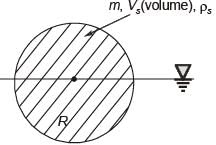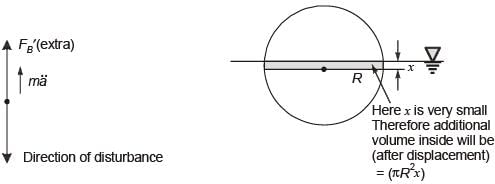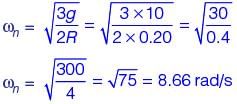GATE Exam > GATE Questions > A hollow spherical ball of radius 20 cm float...
Start Learning for Free
A hollow spherical ball of radius 20 cm floats in still water, with half of its volume submerged. Taking the density of water as 1000 kg/m3, and the acceleration due to gravity as 10 m/s2, the natural frequency of small oscillations of the ball, normal to the water surface is _________ radians/s (roundoff to 2 decimal places).
Correct answer is '8.66'. Can you explain this answer?
| FREE This question is part of | Download PDF Attempt this Test |
Verified Answer
A hollow spherical ball of radius 20 cm floats in still water, with ha...
Given data:
R = 20 cm = 0.20 m
ρ = 1000 kg/m3
g = 10 m/s2

mg =










R = 20 cm = 0.20 m
ρ = 1000 kg/m3
g = 10 m/s2


mg =











Most Upvoted Answer
A hollow spherical ball of radius 20 cm floats in still water, with ha...
To find the natural frequency of small oscillations of the hollow spherical ball, we can use the concept of buoyancy and the equation for the natural frequency of a simple harmonic oscillator.
1. Buoyancy and Submerged Volume:
- The buoyant force acting on an object submerged in a fluid is equal to the weight of the fluid displaced by the object.
- In this case, the buoyant force acting on the ball is equal to the weight of the water displaced by the submerged volume of the ball.
- Since half of the volume of the ball is submerged, the submerged volume can be calculated as follows:
- Submerged Volume = (1/2) * Volume of the ball
2. Equation for Natural Frequency:
- The equation for the natural frequency of a simple harmonic oscillator is given by:
- ω = √(k/m)
- where ω is the natural frequency, k is the spring constant, and m is the mass of the object.
3. Equivalent Spring Constant:
- For a floating object, the buoyant force acting on the object acts as a restoring force, similar to a spring.
- The equivalent spring constant can be calculated using Hooke's Law:
- F = k * x
- where F is the restoring force, k is the spring constant, and x is the displacement from the equilibrium position.
- In this case, the restoring force is equal to the weight of the submerged volume of the ball, and the displacement is equal to the depth to which the ball is submerged.
- The equivalent spring constant can be expressed as:
- k = (Weight of submerged volume) / (Depth of submersion)
4. Weight of Submerged Volume:
- The weight of the submerged volume of the ball can be calculated as follows:
- Weight of submerged volume = (Density of water) * (Volume of submerged volume) * (Acceleration due to gravity)
- Since the density of water is given as 1000 kg/m^3 and the acceleration due to gravity is 10 m/s^2, the weight of the submerged volume becomes:
- Weight of submerged volume = 1000 * (Volume of submerged volume)
5. Volume of Submerged Volume:
- The volume of the submerged volume can be calculated as follows:
- Volume of submerged volume = (4/3) * π * (Radius of ball)^3
6. Depth of Submersion:
- Since half of the volume of the ball is submerged, the depth of submersion can be calculated as follows:
- Depth of submersion = (1/2) * (Diameter of ball)
- Diameter of ball = 2 * (Radius of ball)
7. Calculation:
- Substituting the values into the equations, we have:
- Volume of submerged volume = (4/3) * π * (20 cm)^3
- Depth of submersion = (1/2) * (2 * 20 cm)
- Weight of submerged volume = 1000 * [(4/3) * π * (20 cm)^3]
- Equivalent spring constant, k = (Weight of submerged volume) / (Depth of submersion)
- ω = √(k/m)
- Calculating the values and rounding off to 2 decimal places, we find that the natural frequency of small oscillations of the ball is
1. Buoyancy and Submerged Volume:
- The buoyant force acting on an object submerged in a fluid is equal to the weight of the fluid displaced by the object.
- In this case, the buoyant force acting on the ball is equal to the weight of the water displaced by the submerged volume of the ball.
- Since half of the volume of the ball is submerged, the submerged volume can be calculated as follows:
- Submerged Volume = (1/2) * Volume of the ball
2. Equation for Natural Frequency:
- The equation for the natural frequency of a simple harmonic oscillator is given by:
- ω = √(k/m)
- where ω is the natural frequency, k is the spring constant, and m is the mass of the object.
3. Equivalent Spring Constant:
- For a floating object, the buoyant force acting on the object acts as a restoring force, similar to a spring.
- The equivalent spring constant can be calculated using Hooke's Law:
- F = k * x
- where F is the restoring force, k is the spring constant, and x is the displacement from the equilibrium position.
- In this case, the restoring force is equal to the weight of the submerged volume of the ball, and the displacement is equal to the depth to which the ball is submerged.
- The equivalent spring constant can be expressed as:
- k = (Weight of submerged volume) / (Depth of submersion)
4. Weight of Submerged Volume:
- The weight of the submerged volume of the ball can be calculated as follows:
- Weight of submerged volume = (Density of water) * (Volume of submerged volume) * (Acceleration due to gravity)
- Since the density of water is given as 1000 kg/m^3 and the acceleration due to gravity is 10 m/s^2, the weight of the submerged volume becomes:
- Weight of submerged volume = 1000 * (Volume of submerged volume)
5. Volume of Submerged Volume:
- The volume of the submerged volume can be calculated as follows:
- Volume of submerged volume = (4/3) * π * (Radius of ball)^3
6. Depth of Submersion:
- Since half of the volume of the ball is submerged, the depth of submersion can be calculated as follows:
- Depth of submersion = (1/2) * (Diameter of ball)
- Diameter of ball = 2 * (Radius of ball)
7. Calculation:
- Substituting the values into the equations, we have:
- Volume of submerged volume = (4/3) * π * (20 cm)^3
- Depth of submersion = (1/2) * (2 * 20 cm)
- Weight of submerged volume = 1000 * [(4/3) * π * (20 cm)^3]
- Equivalent spring constant, k = (Weight of submerged volume) / (Depth of submersion)
- ω = √(k/m)
- Calculating the values and rounding off to 2 decimal places, we find that the natural frequency of small oscillations of the ball is

|
Explore Courses for GATE exam
|

|
Similar GATE Doubts
A hollow spherical ball of radius 20 cm floats in still water, with half of its volume submerged. Taking the density of water as 1000 kg/m3, and the acceleration due to gravity as 10 m/s2, the natural frequency of small oscillations of the ball, normal to the water surface is _________ radians/s (roundoff to 2 decimal places).Correct answer is '8.66'. Can you explain this answer?
Question Description
A hollow spherical ball of radius 20 cm floats in still water, with half of its volume submerged. Taking the density of water as 1000 kg/m3, and the acceleration due to gravity as 10 m/s2, the natural frequency of small oscillations of the ball, normal to the water surface is _________ radians/s (roundoff to 2 decimal places).Correct answer is '8.66'. Can you explain this answer? for GATE 2024 is part of GATE preparation. The Question and answers have been prepared according to the GATE exam syllabus. Information about A hollow spherical ball of radius 20 cm floats in still water, with half of its volume submerged. Taking the density of water as 1000 kg/m3, and the acceleration due to gravity as 10 m/s2, the natural frequency of small oscillations of the ball, normal to the water surface is _________ radians/s (roundoff to 2 decimal places).Correct answer is '8.66'. Can you explain this answer? covers all topics & solutions for GATE 2024 Exam. Find important definitions, questions, meanings, examples, exercises and tests below for A hollow spherical ball of radius 20 cm floats in still water, with half of its volume submerged. Taking the density of water as 1000 kg/m3, and the acceleration due to gravity as 10 m/s2, the natural frequency of small oscillations of the ball, normal to the water surface is _________ radians/s (roundoff to 2 decimal places).Correct answer is '8.66'. Can you explain this answer?.
A hollow spherical ball of radius 20 cm floats in still water, with half of its volume submerged. Taking the density of water as 1000 kg/m3, and the acceleration due to gravity as 10 m/s2, the natural frequency of small oscillations of the ball, normal to the water surface is _________ radians/s (roundoff to 2 decimal places).Correct answer is '8.66'. Can you explain this answer? for GATE 2024 is part of GATE preparation. The Question and answers have been prepared according to the GATE exam syllabus. Information about A hollow spherical ball of radius 20 cm floats in still water, with half of its volume submerged. Taking the density of water as 1000 kg/m3, and the acceleration due to gravity as 10 m/s2, the natural frequency of small oscillations of the ball, normal to the water surface is _________ radians/s (roundoff to 2 decimal places).Correct answer is '8.66'. Can you explain this answer? covers all topics & solutions for GATE 2024 Exam. Find important definitions, questions, meanings, examples, exercises and tests below for A hollow spherical ball of radius 20 cm floats in still water, with half of its volume submerged. Taking the density of water as 1000 kg/m3, and the acceleration due to gravity as 10 m/s2, the natural frequency of small oscillations of the ball, normal to the water surface is _________ radians/s (roundoff to 2 decimal places).Correct answer is '8.66'. Can you explain this answer?.
Solutions for A hollow spherical ball of radius 20 cm floats in still water, with half of its volume submerged. Taking the density of water as 1000 kg/m3, and the acceleration due to gravity as 10 m/s2, the natural frequency of small oscillations of the ball, normal to the water surface is _________ radians/s (roundoff to 2 decimal places).Correct answer is '8.66'. Can you explain this answer? in English & in Hindi are available as part of our courses for GATE.
Download more important topics, notes, lectures and mock test series for GATE Exam by signing up for free.
Here you can find the meaning of A hollow spherical ball of radius 20 cm floats in still water, with half of its volume submerged. Taking the density of water as 1000 kg/m3, and the acceleration due to gravity as 10 m/s2, the natural frequency of small oscillations of the ball, normal to the water surface is _________ radians/s (roundoff to 2 decimal places).Correct answer is '8.66'. Can you explain this answer? defined & explained in the simplest way possible. Besides giving the explanation of
A hollow spherical ball of radius 20 cm floats in still water, with half of its volume submerged. Taking the density of water as 1000 kg/m3, and the acceleration due to gravity as 10 m/s2, the natural frequency of small oscillations of the ball, normal to the water surface is _________ radians/s (roundoff to 2 decimal places).Correct answer is '8.66'. Can you explain this answer?, a detailed solution for A hollow spherical ball of radius 20 cm floats in still water, with half of its volume submerged. Taking the density of water as 1000 kg/m3, and the acceleration due to gravity as 10 m/s2, the natural frequency of small oscillations of the ball, normal to the water surface is _________ radians/s (roundoff to 2 decimal places).Correct answer is '8.66'. Can you explain this answer? has been provided alongside types of A hollow spherical ball of radius 20 cm floats in still water, with half of its volume submerged. Taking the density of water as 1000 kg/m3, and the acceleration due to gravity as 10 m/s2, the natural frequency of small oscillations of the ball, normal to the water surface is _________ radians/s (roundoff to 2 decimal places).Correct answer is '8.66'. Can you explain this answer? theory, EduRev gives you an
ample number of questions to practice A hollow spherical ball of radius 20 cm floats in still water, with half of its volume submerged. Taking the density of water as 1000 kg/m3, and the acceleration due to gravity as 10 m/s2, the natural frequency of small oscillations of the ball, normal to the water surface is _________ radians/s (roundoff to 2 decimal places).Correct answer is '8.66'. Can you explain this answer? tests, examples and also practice GATE tests.

|
Explore Courses for GATE exam
|

|
Suggested Free Tests
Signup for Free!
Signup to see your scores go up within 7 days! Learn & Practice with 1000+ FREE Notes, Videos & Tests.


















